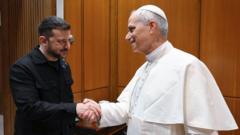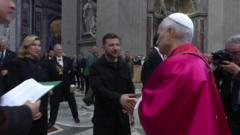The age-old tradition of using smoke signals to announce the election of a new pope is critical to Vatican culture. This ceremony, steeped in history, not only brings together cardinals for a vital decision but also captivates the global audience waiting outside for the telltale colors wafting from the Sistine Chapel.
Black and White Smoke: The Vatican's Symbol for a New Pope

Black and White Smoke: The Vatican's Symbol for a New Pope
As papal conclaves commence, the Vatican uses colored smoke to communicate election results to the world.
As soon as the cardinals enter the Sistine Chapel to begin voting for the next pope, all eyes shift to a chimney protruding from the chapel, prominently visible from St. Peter’s Square. The smoke that emerges serves a crucial purpose: it is white when a new pope is elected and black if the voting remains inconclusive. This practice dates back to the 19th century, with its roots tracing back to the papal conclaves of that era.
The first recorded instance of using smoke as a communication tool occurred in 1823, according to Frederic J. Baumgartner's "Behind Locked Doors." Before this tradition took hold, cardinals simply burned their ballots without any intention of informing the public of the election outcome. Today, ballots and notes penned by the cardinals are incinerated in a cast-iron stove following each voting round, transforming their physical representations of choice into smoke signals.
Historically, the process included the addition of wet straw to the burning materials to ensure a distinct white color; however, this method has proven to be inconsistent. Notably, during the 1958 conclave, white smoke emerged prematurely on two occasions, leading to confusion as the election for a new pope was still ongoing. As the global community looks on in anticipation, the ritual of colored smoke effectively bridges the gap between the sacred processes of the church and the curious eyes of the world.
The first recorded instance of using smoke as a communication tool occurred in 1823, according to Frederic J. Baumgartner's "Behind Locked Doors." Before this tradition took hold, cardinals simply burned their ballots without any intention of informing the public of the election outcome. Today, ballots and notes penned by the cardinals are incinerated in a cast-iron stove following each voting round, transforming their physical representations of choice into smoke signals.
Historically, the process included the addition of wet straw to the burning materials to ensure a distinct white color; however, this method has proven to be inconsistent. Notably, during the 1958 conclave, white smoke emerged prematurely on two occasions, leading to confusion as the election for a new pope was still ongoing. As the global community looks on in anticipation, the ritual of colored smoke effectively bridges the gap between the sacred processes of the church and the curious eyes of the world.




















